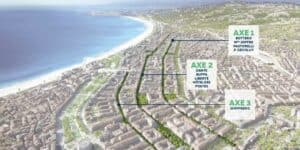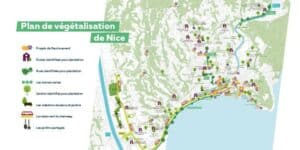
Can urban greening come to the rescue of life in cities?
3 minutes of reading
The summer of 2022 has sadly left its mark on the history of France. Some people see it as the clear consequences, others hear alarm bells ringing… With an unprecedented drought, repeated dramatic fires and record temperatures, France, like other countries around the world, is overheating! This fact highlights the vital and indeed health-giving role played by urban greening.

Climate change is not a new issue. We have been talking about it, predicting and debating it for decades now. However, climate change has never been as visible as it has been over the past months. The month of July, for example, has been the driest since 1961. 40°C has been frequently exceeded in several regions. There have even been shortages of drinking water in over a hundred communities. This disastrous summer has raised serious questions about the quality of life for people and wildlife – in both rural as well as urban areas.
 References: https://www.nice.fr/fr/actualites/la-nature-au-coeur-de-nice/mairie?type=articles
This greening policy has been applied to most of the districts in Nice. In 2019 alone, 10,296 trees were planted.
References: https://www.nice.fr/fr/actualites/la-nature-au-coeur-de-nice/mairie?type=articles
This greening policy has been applied to most of the districts in Nice. In 2019 alone, 10,296 trees were planted.
 Reference: https://www.nice.fr/fr/actualites/la-nature-au-coeur-de-nice/mairie?type=articles
This profound transformation of the city of Nice will be further enhanced by 2025 with two new large-scale green projects:
Reference: https://www.nice.fr/fr/actualites/la-nature-au-coeur-de-nice/mairie?type=articles
This profound transformation of the city of Nice will be further enhanced by 2025 with two new large-scale green projects:
Leaving more room for nature to combat heat islands and pollution
Rather than suffering with the effects of climate change, some cities have already taken action. How? By leaving more room for nature. The aim is manifold: to combat congestion, air pollution and heatwaves. This is the overarching goal of many green politicians. After all, it is not only high temperatures which are harmful to human life. They also have a snowball effect. This is evidenced by the fact that even in the countryside air quality has been regularly categorised as ‘poor’. Pollutants are to blame. High levels of ozone (O3) from road traffic, fossil fuel combustion and fires are particularly harmful. This pollutant can be transported over long distances in the air.Planting trees, but not just any old way!
Far from being a miracle cure, tree planting appears to be just one part of the solution for reducing heat and purifying the air. However, this has to be planned appropriately. What does this mean? Although plants can reduce heat by creating shade, they depend on the absorption and reflection of the sun’s rays to function. According to the ‘Aménager la nature en ville’ (Managing Nature in the City) guide by the French Environment and Energy Management Agency (ADEME), certain features therefore need to be in place to encourage this process. The presence of water, for example, plays an important role in humidifying the air. The soil must be able to collect and store water in order to initiate evapotranspiration from the soil and plants. This is all the more significant as water is becoming increasingly scarce.The real health benefits of greening
Be careful not to rush into things as far as air quality is concerned! It is not often talked about, but trees also have their drawbacks. Allergens are top of the list. Some of these can accumulate in cities due to a lack of wind circulation. Even worse, allergens in combination with solar radiation can be an additional source of ozone production. As a result, both care and knowledge are needed to choose which species to plant and which to leave out in order to achieve breathable and non-irritating air! However, it is worth all the effort as a mature tree can absorb up to 20 kg of fine particles per year. In Lyon, a study has shown that tree-filled urban areas are 2°C to 8°C cooler than the rest of the city. Another advantage of trees, -and one which is not to be underestimated at a time when causes of stress are on the increase, is that they improve the well-being and mental health of residents. Greening has a positive impact on people, including regulating heart rate and blood pressure, improving self-esteem, and enhancing creativity and a feeling of happiness. A study carried out in 2015 in Toronto showed that planting ten additional trees per residential block delayed the onset of age-related health problems by about seven years. These benefits are in line with the findings of the Nature Conservancy, an American environmental NGO, – which were reported in an article published by the newspaper Le Monde in 2016. The report stated that it had analysed 245 of the world’s largest metropolises. The NGO also claimed from the study that by investing just $4 (€3.6) per person in tree planting, these 245 cities could save between 11,000 and 37,000 lives per year and improve the health of tens of thousands of people. How? By simply reducing air pollution and bringing more fresh air to the streets. ‘Trees cannot, and should not, be a substitute for other air purification measures, but they are a powerful means of cleaning and cooling the air which can be used alongside.’ » ONG Nature ConservancyDid you know?
Cerema* (Centre for Studies and Expertise on Risks, the Environment, Mobility and Urban Planning) has created the Sesame tool to help local authorities and public stakeholders choose plants suitable for urban greening. This practical tool allows you to find the best planting solution for:- cooling a city with water and plants
- choosing the right tree and shrub planting combinations for inorganic and polluted urban environments
- achieving a good cohabitation between inhabited areas and biodiversity
An example is set!
Nice – the greenest city in France With over 75% of its area covered by green spaces and half of its area covered by tree-filled spaces, Nice has been elected ‘greenest city in France’ by the LeLynx.fr. website. This is recognition of a job well done! Since 2008, the city has been implementing an ambitious greening project which has included 33 hectares of greenery, 16 new parks and gardens, 7 community gardens and around 100 educational gardens. In Nice, greening is happening (almost) everywhere. This should create a lasting link between the inhabitants and nature – in particular through educational activities for the population. Three green corridors have also been created recently. This work will be completed in 2023. What is the aim? It is to transform three of the main arteries in and around the city centre into garden streets with cycle paths. These streets will be in tune with the times and ultimately will have room for everyone, including vehicles, greener modes of transport, pedestrians and plants! This approach has made it possible to create several miles of green areas at the entrances to homes and businesses. The result will be:- reduced air temperature
- improved absorption of carbon
- increased soil permeability (to prevent the effects of heavy rainfall in winter)
- the creation of a pleasant place to live which matches the French people’s desire for greenery.
 References: https://www.nice.fr/fr/actualites/la-nature-au-coeur-de-nice/mairie?type=articles
This greening policy has been applied to most of the districts in Nice. In 2019 alone, 10,296 trees were planted.
References: https://www.nice.fr/fr/actualites/la-nature-au-coeur-de-nice/mairie?type=articles
This greening policy has been applied to most of the districts in Nice. In 2019 alone, 10,296 trees were planted.
- 1,000 trees on the 3 green corridors (greenways 1, 2 and 3)
- 2,400 trees planted alongside Line 2 of the tramway
- 385 trees in 28 city parks
- 265 trees and palm trees on the Promenade des Anglais
- 52 fruit trees in 15 schools
- 150 trees along the banks of the Paillon river
- 44 trees on Avenue Borriglione, Rue d’Angleterre and Place Pierre Gautier
- 4,500 saplings for the ‘1 child = 1 tree’ initiative
- 1,500 young trees on the Colline du Château
 Reference: https://www.nice.fr/fr/actualites/la-nature-au-coeur-de-nice/mairie?type=articles
This profound transformation of the city of Nice will be further enhanced by 2025 with two new large-scale green projects:
Reference: https://www.nice.fr/fr/actualites/la-nature-au-coeur-de-nice/mairie?type=articles
This profound transformation of the city of Nice will be further enhanced by 2025 with two new large-scale green projects:
- The extension of the Coulée Verte (green corridor) in Nice This vast ‘green oasis’, currently covering 12 hectares in the centre of the city, will be extended by a further 8 hectares of greenery within three years.
- The creation of a second green corridor covering 30 hectares to the west of the city – between the Stade Charles Ehrmann and the Allianz Riviera.
More reading
Read also




What lies ahead? 7 megatrends and their influence on construction, real estate and urban development
Article
20 minutes of reading

